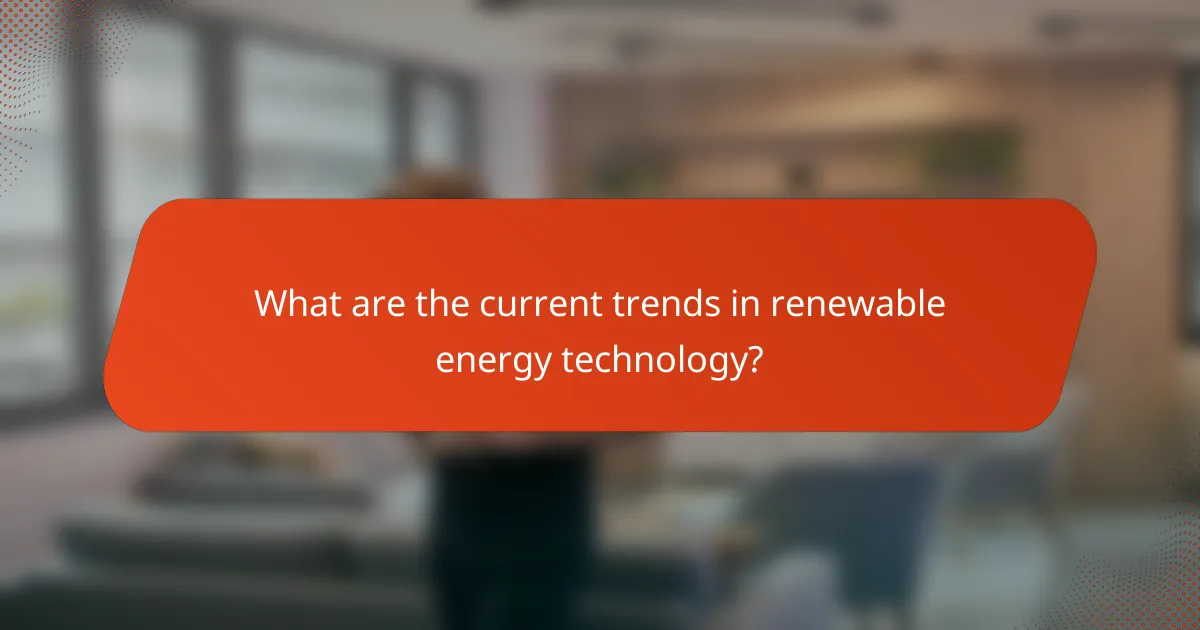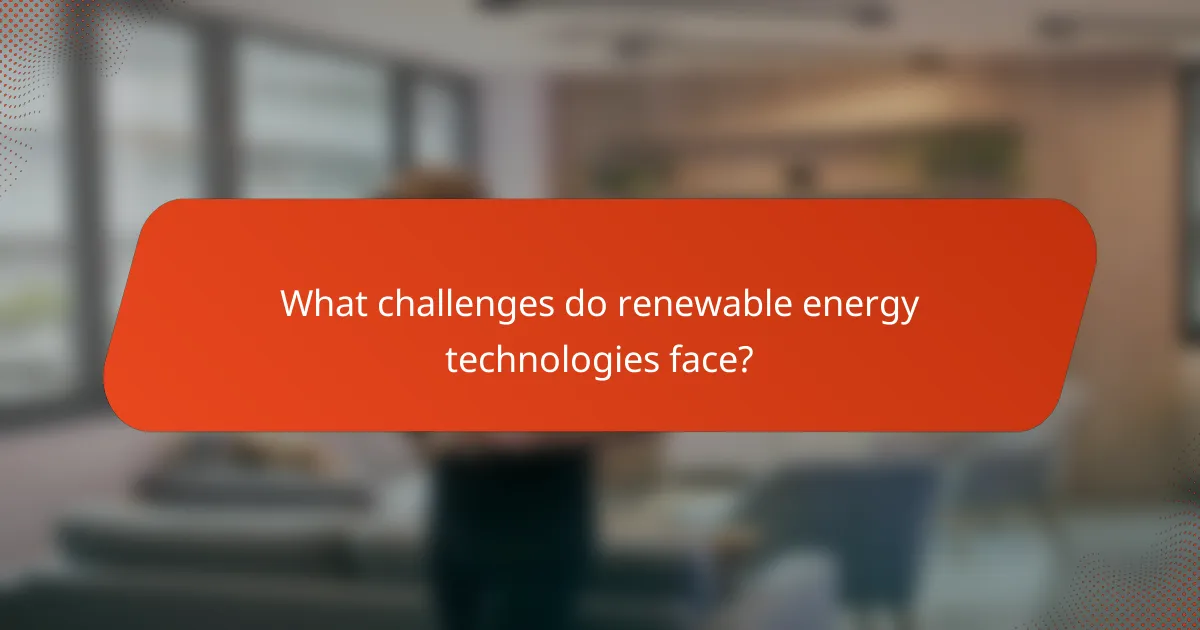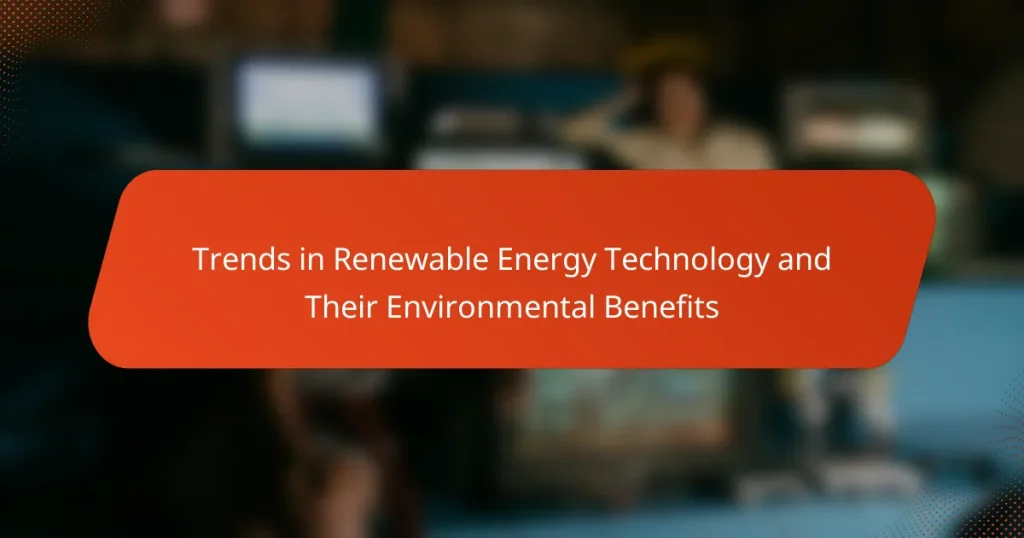The article focuses on renewable energy technology trends and their environmental benefits. Key advancements include increased efficiency in solar photovoltaic (PV) systems, significant growth in wind energy capacity, and developments in battery storage and green hydrogen production. These technologies contribute to reduced greenhouse gas emissions and improved public health by minimizing air pollution. However, challenges such as intermittency, high initial costs, regulatory hurdles, and competition from fossil fuels hinder the widespread adoption of renewable energy solutions. Overall, the article highlights the importance of transitioning to sustainable energy sources for long-term environmental stability.

What are the current trends in renewable energy technology?
Current trends in renewable energy technology include the increased adoption of solar and wind energy. Solar photovoltaic (PV) technology is becoming more efficient, with average efficiencies exceeding 20%. Wind energy capacity is also expanding, with global installed capacity reaching over 700 GW in 2022. Battery storage technology is advancing, enhancing energy reliability and grid stability. Innovations in green hydrogen production are gaining traction, offering a clean fuel alternative. Additionally, smart grid technology is improving energy management and distribution. These trends reflect a global shift towards sustainable energy solutions.
How is innovation shaping the renewable energy landscape?
Innovation is significantly shaping the renewable energy landscape by enhancing efficiency and reducing costs. Technologies such as solar panels have become more efficient due to advancements in materials and design. Wind energy systems are now equipped with larger turbines that capture more energy. Energy storage solutions, like lithium-ion batteries, have improved, enabling better management of renewable sources. Smart grid technologies allow for more effective integration of renewable energy into existing power systems. According to the International Renewable Energy Agency, the cost of solar energy has dropped by 89% since 2009. Additionally, the global capacity for wind energy has quadrupled in the last decade. These innovations are driving a transition towards cleaner energy sources and supporting global climate goals.
What are the latest advancements in solar energy technology?
Recent advancements in solar energy technology include bifacial solar panels and perovskite solar cells. Bifacial panels capture sunlight from both sides, increasing energy output by up to 30%. Perovskite solar cells offer higher efficiency rates and lower production costs compared to traditional silicon cells.
Additionally, solar tracking systems have improved, allowing panels to follow the sun’s path. This can enhance energy capture by 25% or more. Energy storage solutions, such as lithium-ion batteries, have also advanced, facilitating better integration of solar power into the grid.
These developments contribute to the declining cost of solar energy. According to the International Renewable Energy Agency, the cost of solar photovoltaics has fallen by 89% since 2009. These innovations position solar energy as a leading solution in the transition to renewable energy sources.
How are wind energy technologies evolving?
Wind energy technologies are evolving through advancements in turbine design, efficiency, and integration with smart grids. Modern turbines are larger and more efficient, with some reaching over 12 MW in capacity. Innovations in materials, such as lighter blades, enhance performance and durability. The use of artificial intelligence optimizes energy production and maintenance schedules. Offshore wind farms are becoming more prevalent, utilizing floating turbine technology to harness deeper waters. These developments contribute to reduced costs and increased energy output. According to the Global Wind Energy Council, global wind capacity reached 743 GW in 2020, reflecting rapid growth and technological advancement.
What role does government policy play in renewable energy trends?
Government policy significantly influences renewable energy trends. It shapes the regulatory framework and financial incentives for renewable energy projects. Policies such as tax credits, subsidies, and renewable portfolio standards encourage investment in renewable technologies. For example, the Investment Tax Credit (ITC) in the U.S. has spurred solar energy growth, leading to a 167% increase in installed solar capacity from 2015 to 2020. Additionally, government commitments to reduce carbon emissions drive innovation in renewable energy sectors. Countries with ambitious climate goals often see accelerated development in wind, solar, and other renewable technologies. Overall, effective government policy is crucial for advancing renewable energy adoption and reducing reliance on fossil fuels.
How do incentives and subsidies impact renewable energy adoption?
Incentives and subsidies significantly enhance renewable energy adoption. They lower the financial barriers for consumers and businesses. For example, tax credits can reduce the upfront costs of solar panels. This makes renewable energy more accessible. According to the International Renewable Energy Agency, government incentives have led to a 20% increase in solar capacity from 2010 to 2020. Additionally, subsidies encourage investment in renewable technologies. This results in job creation and economic growth within the sector. Overall, financial support is crucial for accelerating the transition to renewable energy sources.
What are the effects of international agreements on renewable energy technologies?
International agreements significantly influence renewable energy technologies. They create frameworks for cooperation and set targets for emissions reductions. Agreements like the Paris Accord encourage countries to invest in renewable technologies. They also promote knowledge sharing and technology transfer among nations. For instance, the International Renewable Energy Agency (IRENA) reports increased investments due to such agreements. Countries are more likely to adopt renewable energy policies when bound by international commitments. Moreover, these agreements often lead to financial incentives for renewable projects. Overall, international agreements drive innovation and accelerate the deployment of renewable energy technologies.

Why are renewable energy technologies important for the environment?
Renewable energy technologies are important for the environment because they reduce greenhouse gas emissions. Unlike fossil fuels, renewables such as solar and wind energy produce little to no carbon dioxide during operation. This reduction in emissions helps combat climate change and global warming. Additionally, renewable technologies decrease air pollution, which improves public health. For instance, the use of wind energy can prevent approximately 329 million metric tons of carbon dioxide from being released annually. Furthermore, renewable energy sources are sustainable and can be replenished naturally, ensuring long-term environmental stability. They also minimize water usage compared to conventional energy sources, preserving vital water resources. Overall, the transition to renewable energy is crucial for creating a cleaner and healthier planet.
How do renewable energy technologies reduce greenhouse gas emissions?
Renewable energy technologies reduce greenhouse gas emissions by replacing fossil fuels with cleaner energy sources. These technologies include solar, wind, hydroelectric, and geothermal energy. Each of these sources produces little to no direct emissions during operation. For example, solar panels convert sunlight into electricity without burning fossil fuels. Wind turbines harness wind energy, generating power without emissions. Hydroelectric plants utilize flowing water to produce energy, also avoiding greenhouse gases. According to the International Renewable Energy Agency (IRENA), the global transition to renewable energy could reduce carbon dioxide emissions by up to 70% by 2050. This significant reduction demonstrates the effectiveness of renewable technologies in combating climate change.
What specific emissions are mitigated by renewable energy sources?
Renewable energy sources mitigate several specific emissions, primarily carbon dioxide (CO2), sulfur dioxide (SO2), and nitrogen oxides (NOx). These emissions are major contributors to air pollution and climate change. Renewable energy, such as wind, solar, and hydro, generates electricity without burning fossil fuels. For instance, replacing coal with wind energy can reduce CO2 emissions by up to 90%. Additionally, renewable sources significantly lower SO2 and NOx emissions, which are linked to acid rain and respiratory problems. According to the U.S. Environmental Protection Agency, transitioning to renewable energy can lead to a substantial decrease in harmful emissions, improving air quality and public health.
How do renewable energy technologies contribute to air quality improvement?
Renewable energy technologies contribute to air quality improvement by reducing emissions of pollutants. These technologies, such as solar, wind, and hydroelectric power, generate energy without burning fossil fuels. This leads to lower levels of carbon dioxide, sulfur dioxide, and nitrogen oxides in the atmosphere. According to the U.S. Environmental Protection Agency, transitioning to renewable energy could reduce air pollution-related health issues. Studies show that areas using more renewable energy report improved air quality metrics. For instance, a report from the National Renewable Energy Laboratory indicates significant reductions in particulate matter in regions adopting wind and solar energy.
What are the ecological benefits of adopting renewable energy technologies?
Adopting renewable energy technologies significantly reduces greenhouse gas emissions. This transition decreases air pollution, leading to improved public health. Renewable energy sources, such as solar and wind, produce minimal waste compared to fossil fuels. They also conserve water, as many renewable technologies require less water for operation. Additionally, renewable energy promotes biodiversity by reducing habitat destruction associated with fossil fuel extraction. According to the International Renewable Energy Agency (IRENA), increasing renewable energy can reduce global carbon dioxide emissions by up to 70% by 2050. This shift not only mitigates climate change but also enhances ecosystem resilience.
How do renewable energy sources preserve biodiversity?
Renewable energy sources preserve biodiversity by minimizing habitat destruction and reducing pollution. Unlike fossil fuels, renewable energy systems such as wind, solar, and hydroelectric power have a lower environmental impact. They help maintain ecosystems by avoiding the degradation associated with traditional energy extraction methods. For instance, solar farms can coexist with agricultural land, promoting biodiversity. Wind turbines can be strategically placed to avoid migratory bird pathways, reducing wildlife fatalities. Additionally, renewable energy reduces greenhouse gas emissions, mitigating climate change and its adverse effects on various species. Research indicates that transitioning to renewable energy could significantly decrease the extinction risk for many species affected by climate change.
What impact do renewable technologies have on water conservation?
Renewable technologies significantly contribute to water conservation. Solar and wind energy systems require minimal water for operation compared to fossil fuel power plants. For example, conventional coal and natural gas plants can use thousands of gallons of water per megawatt-hour for cooling. In contrast, solar photovoltaic systems use no water during energy generation.
Additionally, hydropower can impact water resources but often includes measures to enhance water management. For instance, modern hydropower plants can incorporate fish ladders and other technologies to minimize ecological disruption.
Moreover, renewable technologies promote sustainable practices. They encourage the use of recycled water in agricultural applications, reducing the demand for freshwater. A study by the National Renewable Energy Laboratory found that integrating renewable energy systems can lead to a reduction in overall water usage in energy production by up to 90%.
These advancements highlight the positive role of renewable technologies in promoting water conservation.

What challenges do renewable energy technologies face?
Renewable energy technologies face several significant challenges. One major challenge is intermittency, which affects energy generation from sources like solar and wind. These sources do not produce energy consistently, leading to supply fluctuations. Energy storage solutions, such as batteries, are still developing and can be costly.
Another challenge is the high initial capital costs associated with renewable energy installations. For example, solar panels and wind turbines require substantial investment upfront. Additionally, grid integration poses difficulties, as existing energy infrastructure may not accommodate new renewable sources efficiently.
Regulatory hurdles also impact the deployment of renewable technologies. Policies may not support or incentivize the transition to renewable energy effectively. Moreover, public perception and acceptance can hinder projects, especially in local communities.
Lastly, competition from fossil fuels remains a challenge. Despite growing awareness of climate change, fossil fuels often remain cheaper in many regions. These challenges collectively hinder the widespread adoption and scalability of renewable energy technologies.
How do economic factors influence the growth of renewable energy technologies?
Economic factors significantly influence the growth of renewable energy technologies. Investment levels determine the pace of technological advancements. Increased funding leads to research and development, enhancing efficiency and reducing costs. Government policies, such as subsidies and tax incentives, promote adoption. For instance, the U.S. solar market grew by 167% from 2010 to 2016 due to supportive policies. Market demand also drives growth; rising energy prices make renewables more attractive. Furthermore, economies of scale lower production costs over time, encouraging wider deployment. Overall, strong economic conditions foster innovation and expansion in renewable energy sectors.
What are the financial barriers to renewable energy adoption?
High upfront costs are a primary financial barrier to renewable energy adoption. Many renewable energy technologies require significant initial investments. For instance, solar panel installation costs can exceed $20,000 for residential systems. This high cost can deter potential adopters, especially in low-income households. Additionally, financing options may be limited or come with high-interest rates. This limits access to capital for those interested in renewable energy solutions. Furthermore, the lack of incentives or subsidies can exacerbate these financial challenges. In many regions, government support for renewable energy is insufficient. As a result, potential users may opt for cheaper, non-renewable energy sources.
How does market competition affect renewable energy technologies?
Market competition drives innovation in renewable energy technologies. Increased competition leads to lower costs and improved efficiency. For example, solar panel prices have dropped by over 80% since 2010 due to competitive advancements. This price reduction makes renewable energy more accessible to consumers. Additionally, competition fosters research and development. Companies invest in new technologies to gain a market edge. This results in breakthroughs like more efficient wind turbines and advanced battery storage solutions. Furthermore, competition encourages diverse energy sources. A variety of renewable options can meet different regional needs. Overall, market competition significantly accelerates the growth and adoption of renewable energy technologies.
What technological hurdles must be overcome for wider adoption?
Technological hurdles for wider adoption of renewable energy include energy storage, grid integration, and cost reduction. Energy storage solutions, such as batteries, need to improve in efficiency and capacity. Current battery technologies limit the ability to store energy generated from renewable sources. Grid integration requires advanced infrastructure to manage variable energy supply. Many existing grids are not equipped to handle the fluctuations from renewable sources like solar and wind. Additionally, the cost of renewable technologies must decrease to compete with fossil fuels. According to the International Renewable Energy Agency, the cost of solar photovoltaic systems has dropped by 82% since 2010. These factors collectively hinder the scalability and adoption of renewable energy technologies.
What are the limitations of current renewable energy storage solutions?
Current renewable energy storage solutions face several limitations. First, they often have high costs associated with production and installation. For instance, lithium-ion batteries, commonly used for storage, can be expensive, with costs around $400 per kWh. Second, energy density is a challenge; many storage technologies cannot store sufficient energy for prolonged use. Pumped hydro storage, while effective, requires specific geographical conditions and can lead to ecological disruption. Third, the lifespan of storage systems can be limited; batteries may only last 5 to 15 years before needing replacement. Fourth, charging and discharging rates vary, impacting efficiency during peak demand. Lastly, recycling and disposal of materials like lithium pose environmental concerns. These limitations hinder the widespread adoption of renewable energy storage solutions.
How can grid integration challenges be addressed?
Grid integration challenges can be addressed through advanced technology and policy frameworks. Implementing smart grid technologies enhances real-time monitoring and control. This improves the reliability of energy distribution. Energy storage solutions, like batteries, mitigate supply and demand fluctuations. Regulatory reforms can facilitate easier integration of renewable sources. For instance, net metering policies incentivize solar energy adoption. Investment in infrastructure upgrades supports increased capacity for renewable energy sources. Collaborative efforts among utilities, governments, and stakeholders ensure coordinated approaches. Research shows that effective grid integration can reduce energy costs by up to 30%.
What practical steps can individuals take to support renewable energy technologies?
Individuals can support renewable energy technologies by adopting energy-efficient practices. They can install solar panels on their properties. This reduces reliance on fossil fuels and lowers energy bills. Individuals should also consider purchasing green energy from their utility providers. This supports the growth of renewable energy sources. Another step is to reduce energy consumption through efficient appliances. Energy Star-rated appliances use less electricity. Additionally, individuals can participate in community solar programs. These programs allow people to invest in shared solar projects. Advocacy for policies that promote renewable energy is also crucial. Supporting legislation that incentivizes clean energy can drive change. Lastly, educating others about renewable energy benefits fosters a supportive community.
The main entity of the article is renewable energy technology, which encompasses advancements in solar, wind, and other sustainable energy sources. The article outlines current trends such as improved solar photovoltaic efficiency, expanded wind energy capacity, and innovations in energy storage and smart grid technologies. It also discusses the role of government policies, financial incentives, and international agreements in promoting renewable energy adoption. Additionally, the environmental benefits of these technologies, including reduced greenhouse gas emissions and improved air quality, are highlighted, along with the challenges faced in their widespread implementation.




